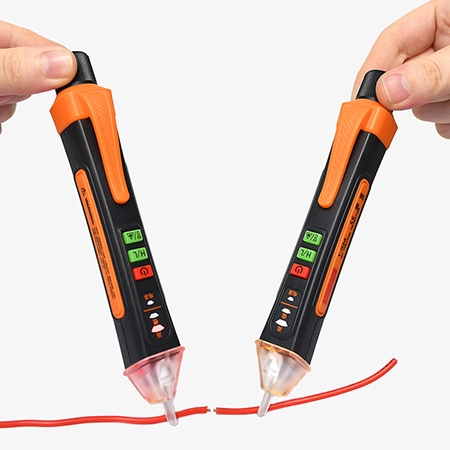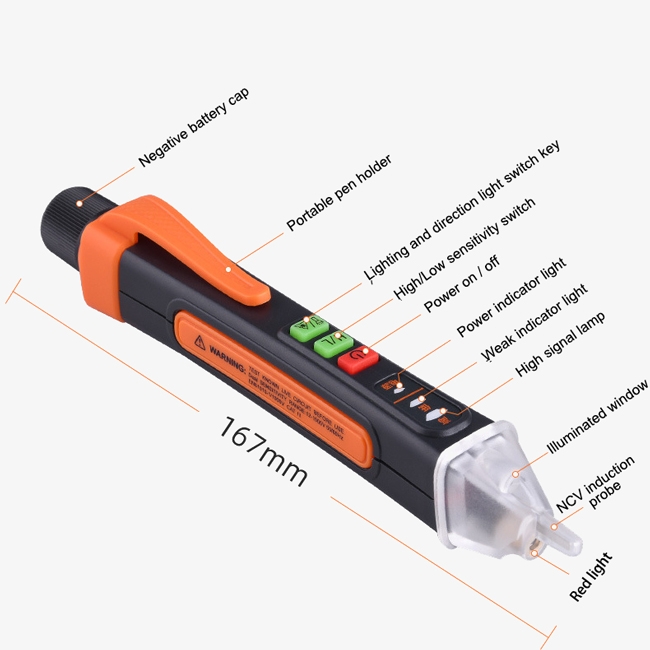High-quality 12V-1000V AC voltage detector is a compact, handheld tool designed for quickly and safely detecting the presence of AC voltage without the need for direct contact with wires or terminals. The no-touch voltage tester pen emits visual and audible alerts when it senses voltage, making it easy to identify live wires.

The AC voltage tester design with a LED flashlight lighting
- LED flashlights enhance visibility in dark or low-light environments, making it easier to see the voltage tester's readings or indicators.
- Using an LED flashlight helps accurately locate wires, outlets, or switches, ensuring the voltage tester’s probes are properly aligned with the test points.
- Adequate lighting speeds up the process and makes testing more efficient in dimly lit environments.

Breakpoint finder function
- Voltage detectors are ideal for quickly identifying breaks or faults in electrical circuits, helping to locate the exact point of failure.
- By testing different points along a circuit, a voltage tester helps you systematically isolate and identify where the break or fault is occurring.
- Voltage tester pens help ensure that you are only working on de-energized sections of the circuit during repair, minimizing the risk of electric shock while identifying circuit breaks.
Applications
SISCO voltage testers are essential tools used in electrical work to determine the presence and level of electrical voltage in circuits and devices. They help ensure safety by allowing electricians and DIY enthusiasts to verify that circuits are de-energized before performing maintenance or installations. Common applications include residential and commercial electrical work, industrial settings, automotive industry, telecommunications, HVAC systems, utilities and power distribution, and renewable energy systems, where they check outlets, wiring, machinery, vehicle electrical systems, communication equipment, HVAC units, power lines, and renewable energy installations for proper voltage and functionality.

Automotive Industry

Telecommunications

HVAC Systems

Commercial Electrical Work
| Model | SISCO-VT-T02A |
| Measuring Voltage | High sensitivity: AC 12-1000V; Low sensitivity: AC 48-1000V |
| Display | LED indication |
| Frequency | 50/60 Hz |
| Alarm mode | Sound and light alarm |
| Probe shape | Oval shape |
| Neutral and live wire judgment | Change according to backlight color: yellow is neutral wire, red is live wire |
| Signal Strength Display | Yellow: weak signal indicator, red: strong signal indicator |
| Signal Strength Indication Method | When the signal is weak, the buzzer sounds slowly and the yellow light is on; when the signal is strong, the buzzer sounds rapidly and the red light is on |
| Automatic shutdown | √ |
| Flashlight | √ |
| Automatic shutdown | √ |
| Safety level | CAT Ⅲ 1000V, CAT Ⅳ 600V |
| Dimensions | 165*25*28mm |
| Weight | 80g |
Detail and Dimension

Q1: What is a voltage tester?
A1: A voltage tester is a tool used to determine the presence and level of electrical voltage in a circuit or device. It helps to ensure safety by allowing users to verify if circuits are live (energized) or de-energized before performing electrical work.
Q2: What are the types of voltage testers?
A2: There are various types of voltage testers, including:
- Non-Contact Voltage Testers (NCVT): Detect voltage by sensing the electric field around a live conductor without making physical contact with it. They usually indicate the presence of voltage through a light, sound, or vibration.
- Contact Voltage Testers: Require direct contact with the conductor to measure voltage. They typically have probes or leads that need to touch the wires or terminals being tested.
- Analog Voltage Testers: Use a needle gauge to show voltage levels. These are less common today but still used in some applications.
Q3: What is the importance of the sampling rate in an AWG?
A3: If your voltage tester isn't detecting voltage, check the following:
- Battery: Replace it if it’s dead.
- Settings: Ensure it’s set to the correct mode and range.
- Tester Condition: Test it on a known live circuit to verify if it’s working.
- Use: Make sure you’re using it correctly and making good contact.
- Power: Verify that the circuit is actually live and turned on.
Tips: What does it mean when a voltage detecor shows a false positive?
When a voltage detector shows a false positive, it means the tester indicates the presence of voltage (a "live" circuit) when, in reality, there is no voltage present. This can lead to confusion and potential safety concerns. Here are some reasons why a false positive might occur:
- Electromagnetic Interference (EMI): Nearby electrical devices, wires, or power lines can emit electromagnetic fields that the voltage tester may mistakenly interpret as voltage in the circuit being tested.
- Induced Voltage: Voltage can be induced in a wire or circuit that is near another live wire, especially in tightly packed electrical panels or conduits. This induced voltage is often not dangerous but can trigger a voltage tester.
- Static Electricity: Static charges on surfaces or in the air can sometimes cause a voltage tester to give a false positive.
- Faulty Tester: A malfunctioning or poorly calibrated voltage tester might give inaccurate readings, including false positives.
- Battery Issues: Low or weak batteries can cause some testers to behave unpredictably, including giving false positives.
Thank you for buying industrial test and measurement equipment on SISCO.com, all products sold by SISCO and the partner cover a 12 months warranty, effective from the date of receiving the products.
What is covered?
SISCO is responsible for providing free spare parts, and free technical support to assist the customer to repair the defective products until the problem is solved.
What is not covered?
- Product purchased from anyone other than a SISCO store or a SISCO authorized reseller.
- Expendable parts.
- Routine cleaning or normal cosmetic and mechanical wear.
- Damage from misuse, abuse or neglect.
- Damage from use of parts other than SISCO approved.
- Damage from use outside the product’s usage or storage parameters.
- Damage from use of parts not sold by SISCO.
- Damage from modification or incorporation into other products.
- Damage from repair or replacement of warranted parts by a service provider other than a SISCO authorized service provider.
- Damage caused by the application environment not meeting the product usage requirements and the failure to perform preventive maintenance.

